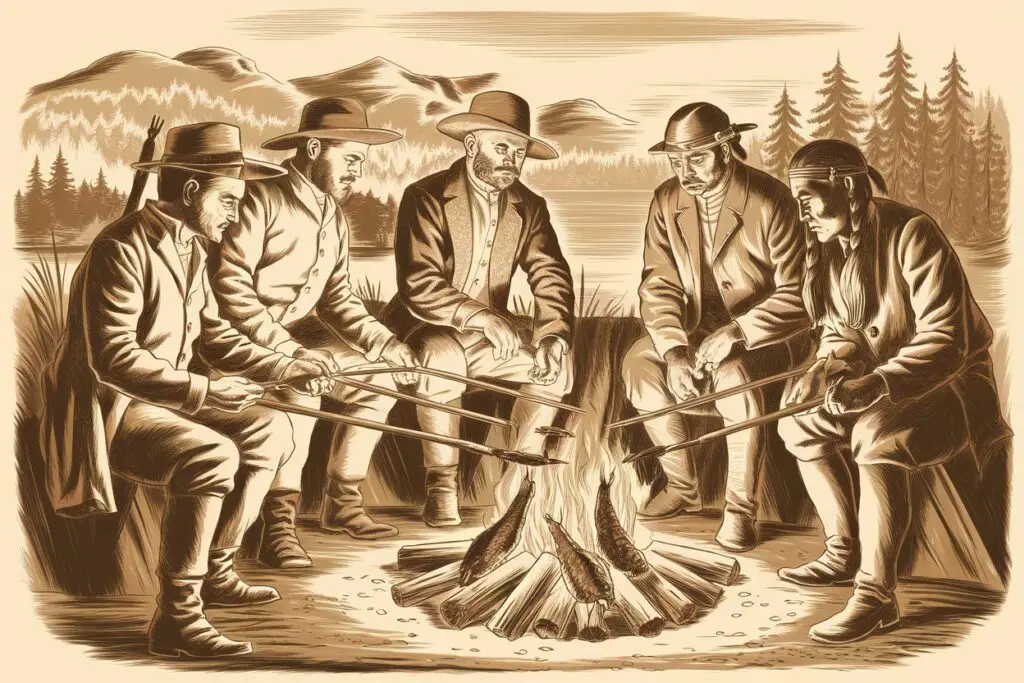1.Turtle Soup—A Delicacy Served at Elite Gatherings
In colonial America, turtle soup was more than just a meal—it was a status symbol. Imported from British culinary traditions, this rich and labor-intensive dish became a hallmark of elite gatherings, often served at banquets hosted by figures like George Washington and Alexander Hamilton (source). The dish was particularly popular in the 18th century, when “turtle frolics” were common social events where entire communities gathered to enjoy the slow-simmered delicacy (source).
Green sea turtles were the preferred choice for this dish, but as their numbers dwindled, colonists turned to terrapins found in local swamps and creeks (source). The preparation was no small feat—turtles were butchered, their meat simmered for hours with herbs and spices, and the broth enriched with Madeira or sherry for added depth of flavor. The soup’s exclusivity stemmed not only from its time-consuming preparation but also from the difficulty of sourcing turtles, making it a dish largely reserved for the wealthy.
By the 19th century, shifting culinary trends and the effects of Prohibition—which restricted access to the wine traditionally used in the soup—led to its decline (source). Today, conservation laws protect sea turtles, making authentic turtle soup a relic of the past. However, its legacy endures in mock turtle soup, a calf’s head-based substitute that preserves the flavors of this once-celebrated dish (source).
2.Roast Beaver Tails—A Favorite Frontier Dish
In colonial America, roast beaver tails were considered a prized delicacy, particularly among frontiersmen and fur trappers. The dish was especially popular in the Great Lakes region, where beaver populations were abundant due to the thriving fur trade. Unlike the rest of the beaver, which provided durable pelts for export, the tail was valued for its rich, fatty content, making it a vital source of calories during harsh winters. Frontiersmen and Native American tribes alike recognized its nutritional benefits, incorporating it into their diets as both a necessity and a treat.

The preparation of beaver tail was simple yet effective. Trappers would roast the tail over an open fire until the tough outer skin blistered and cracked, revealing the gelatinous, fatty interior. Some accounts suggest that after roasting, the charred skin was peeled away, and the exposed fat was further grilled or seasoned for added flavor. The texture was unique—both chewy and tender—while the taste had a mild, slightly gamey quality with a hint of fishiness. Despite its unusual nature by modern standards, beaver tail was a practical and highly valued food source for those living off the land.
Beyond sustenance, beaver tail held cultural significance. For many indigenous tribes, it was considered a delicacy reserved for special occasions or communal feasts. For European settlers, its high-fat content made it an essential survival food, especially in a time when dietary fat was a precious commodity. Over time, as beaver populations declined due to overhunting and the fur trade waned, the dish faded from American tables. Today, it remains a fascinating example of how colonial settlers adapted to their environment, utilizing every available resource to sustain themselves in the wilderness.
3.Squirrel Stew—Turning Small Game into a Hearty Meal
Squirrel stew was a practical and widely consumed dish in Colonial America, reflecting the settlers’ adaptability and reliance on available resources. Squirrels were abundant in the forests of the Thirteen Colonies, making them an easy and accessible source of protein, particularly for frontier families and those living in rural areas. Unlike domesticated livestock, which required time and resources to raise, small game like squirrels could be hunted with minimal effort, ensuring a steady food supply. The practice of consuming squirrel meat was heavily influenced by both European and Native American culinary traditions, which emphasized using every available ingredient to create nourishing meals.
Colonial cooks typically prepared squirrel stew by first skinning and cleaning the animal, then simmering the meat slowly in a pot with vegetables and herbs. Common ingredients included wild onions, turnips, potatoes, and corn—staple crops introduced to European settlers by Native Americans. The long cooking process helped tenderize the lean meat, making it more palatable and easier to digest. In some regions, squirrel stew evolved into variations like Brunswick stew, which also featured other small game such as rabbit or opossum.
This dish was particularly important in frontier and backcountry regions, where access to domesticated livestock was limited. Hunting provided not only sustenance but also a means of survival in an environment where food scarcity was a constant concern. The tradition of squirrel stew has endured in certain parts of the United States, particularly in the Appalachian region, where hunting remains an integral part of local food culture. Today, while less common, squirrel stew continues to be a reminder of early American ingenuity and the ability to make the most of nature’s offerings.
4.Calf’s Foot Jelly—A Sweet but Unusual Dessert
In colonial America, desserts often required ingenuity, and calf’s foot jelly was a prime example. Before the advent of commercial gelatin, colonists extracted natural gelatin from calf’s feet by boiling them for hours. The resulting liquid, rich in collagen, was then strained, sweetened with sugar, and flavored with ingredients like lemon, cinnamon, or even fortified wines such as Madeira or sherry. Once cooled, it set into a translucent, wobbly jelly—a texture that might seem unusual today but was considered a delicacy at the time.
Beyond its role as a dessert, calf’s foot jelly had medicinal value. It was often served to the sick and convalescent, as its high protein content was believed to aid recovery. British culinary traditions heavily influenced colonial cooking, and this dish was no exception. Recipes for calf’s foot jelly appeared in cookbooks like The Compleat Housewife, which was widely used in the colonies. Despite its popularity in the 18th and 19th centuries, the labor-intensive process and changing tastes led to its decline. Today, its legacy lives on in modern gelatin desserts, though few people realize their origins trace back to boiling a calf’s hoof.
5.Eel Pie—A Colonial Staple from the Rivers and Coasts
Eel pie might not be the first dish that comes to mind when thinking of colonial American cuisine, but for early settlers, it was both a practical and popular meal. Eels were abundant in the rivers and coastal waters of the thirteen colonies, making them an easily accessible source of protein. In fact, eels were so valued that colonists often used lobsters—then considered less desirable—as bait to trap them. This preference highlights just how different food perceptions were in the 17th and 18th centuries compared to today.
The dish itself was a direct adaptation of British culinary traditions, where eel pies had been a staple for centuries. Recipes typically involved cleaning and cutting the eels into chunks before seasoning them with onions, pepper, and sometimes nutmeg. Some variations even included raisins for a subtle sweetness. The entire mixture was then baked inside a sturdy pastry crust, which helped preserve the dish for several days—an essential feature in an era without refrigeration.
Eel pie was particularly favored in New England, where rivers teemed with freshwater eels. It was not just a meal of necessity but one of comfort and familiarity, as many colonists had grown up eating similar dishes in England. Over time, however, as food preferences shifted and refrigeration made other meats more accessible, eel pie gradually faded from American tables. Today, it remains a fascinating relic of colonial ingenuity and resourcefulness.
6.Boiled Ox Tongue—A Dish Reserved for Special Occasions
In Colonial America, no part of an animal went to waste, and ox tongue was considered a prized cut, often reserved for special occasions. Unlike modern perceptions of offal as undesirable, colonial cooks valued tongue for its rich, beefy flavor and tender texture when properly prepared. Given the labor-intensive process required to make it palatable, boiled ox tongue was not an everyday meal but a dish served at gatherings where effort and culinary skill were displayed.
The preparation of ox tongue was a meticulous process. First, the tongue was thoroughly cleaned and then boiled for several hours to soften the tough muscle fibers. Once tender, the outer skin was peeled away, revealing the delicate meat beneath. Colonists often seasoned the tongue with vinegar, cloves, and nutmeg—spices that were highly valued at the time. The final dish was sometimes served hot, accompanied by root vegetables, or sliced cold for later consumption.
This dish reflected the broader colonial approach to cooking, which emphasized resourcefulness and full utilization of available ingredients. While ox tongue may seem unusual to modern palates, it was a delicacy that symbolized both practicality and indulgence in early American cuisine.
7.Vinegar Pie—A Dessert Made Without Fruit or Sugar
Vinegar pie might sound like an odd culinary invention, but in colonial America, it was a testament to ingenuity in the kitchen. When fresh fruit was unavailable—especially during harsh winters—resourceful cooks needed an alternative to create a tart, sweet dessert. The solution? Vinegar. This pie, now considered a “desperation pie,” used vinegar to mimic the tangy brightness of citrus, which was often too expensive or difficult to obtain in the colonies. Despite its name, vinegar pie doesn’t taste overwhelmingly sour. Instead, the vinegar subtly enhances the sweetness, creating a flavor profile reminiscent of lemon custard.
The basic recipe consisted of simple, readily available ingredients: eggs, sugar, butter, and either white or apple cider vinegar. Some variations included spices like cinnamon or nutmeg to add depth. The filling was poured into a flaky pie crust and baked until it set into a smooth, custard-like consistency. This dish remained popular well beyond the colonial era, resurfacing during the Great Depression when families once again had to make do with limited ingredients. Today, vinegar pie serves as a fascinating reminder of colonial resilience and culinary adaptability, proving that necessity truly is the mother of invention.







